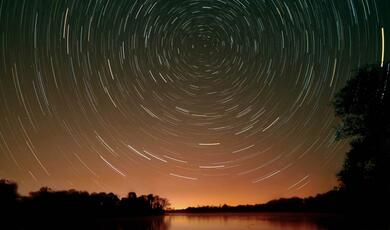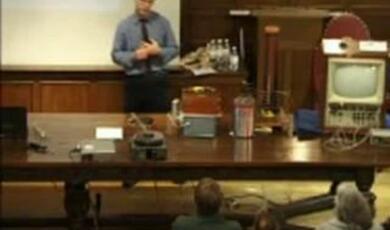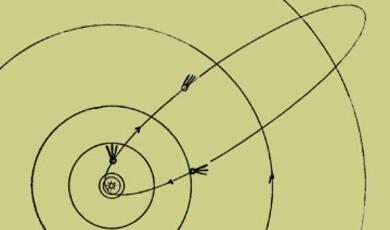The First Stars
Share
- Details
- Text
- Audio
- Downloads
- Extra Reading
Eddington once famously said that a physicist on a cloud-bound planet could predict that there are stars. The first series of lectures will be devoted to fundamental questions that have simple answers. What is a star? What is a galaxy? All devolves around knowing their masses. Why should a star like the sun weigh in at two billion trillion trillion tonnes? No more, no less. And all other stars, countless in number, are between a tenth of a hundred times the mass of the sun.
This leads us into a description of the first stars in the universe.
A short introduction to the topic of this lecture is offered in the following short video by Professor Joseph Silk:
Download Text
04 November 2015
The First Stars
Professor Joseph Silk
Eddington once famously said that a physicist on a cloud-bound planet could predict that there are stars. The first series of Gresham lectures will be devoted to fundamental questions that have simple answers. Today I will discuss what a star is. A galaxy is an agglomeration of billions of stars. All devolves around knowing their masses. Why should a star like the sun weigh in at two billion trillion trillion tons? No more, no less. And all other stars, countless in number, are between a tenth of and a hundred times the mass of the sun. Once we converge on the notion of a star, we inevitably wonder where they came from. This inevitably leads us into a description of the first stars in the universe. Although they disappeared long ago, they left traces and fossils that we try to decipher.
Nearby, in time and space
But let us begin with the nearest star, our Sun. Firstly, how did it form? A cloud of interstellar gas cooled down. It collapsed under its own gravity. The cloud fragmented into dense clumps of cold gas. Each of these gave birth to a star. The forming star is surrounded by a nebula of cold gas and dust that has too much rotation to collapse. Instead, the nebula cools and forms a dusty gaseous disk that spins around the central object, that we refer to as a protostar, destined, as it shrinks further, to be a star. The protostellar disk has its own destiny: it will form planets.
Most of the stars were a tenth of the mass of the sun. Very few were ten solar masses or more. And then there were the sun-like stars. The more massive a star, the more rapidly it aged. Stars radiate by thermonuclear burning of hydrogen in their cores. A helium nucleus has atomic mass four. It consists of two protons and two neutrons. It forms by combining four protons along with two electrons. The helium nucleus weighs seven percent less than four protons. This four percent is released as energy via Einstein's famous equation E=mc 2. That is how the sun battles gravity. Thermonuclear energy supplies the thermal pressure that supports the sun. The fuel supply is good for billions of years.
When the hydrogen fuel supply in the core of the sun, where it is hot enough to burn, is exhausted, the sun contracts and the core heats up. Helium is ignited, and it burns by thermonuclear reactions into carbon. This reaction releases so much luminosity that the outer part of the sun swells up into a red giant. Our sun is fated to become a red giant in about four billion years. At this time the sun's atmosphere would encompass the orbit of the earth, burning any surface organic material into ashes. Once the helium energy supply is exhausted the core contracts into a white-hot star about the size of the earth, but a million times denser. We call this a white dwarf. The atmosphere is ejected in the beautiful phenomenon that we see as a planetary nebula. The white dwarf gradually cools down. Our galaxy is teeming with old white dwarfs, descendants of sun-like stars.
A star that is ten or thirty times the mass of the sun has a much more accelerated evolution. It burns up its nuclear fuel at a rate that goes as the cube of its mass. This means that its lifetime as a hydrogen-burning star may be only a hundred million years or even a few million years. These are tiny time-scales in the grand scheme; many such events occur over the ten billion year time span of our galaxy. So we can use our galaxy as an astronomical zoo: it contains stars at all stages of their evolution, from birth to death. We can visualize the birth, adolescence, maturity and old age of stars.
Eddington's amazing insight
So decades before we knew the energy source that powered the stars, how did famed astronomer Sir Arthur Eddington conclude that stars are inevitable? Eddington made his reputation by being one of the first to understand the significance of Einstein's theory of general relativity, published in 1915. Perhaps as a Quaker and conscientious objector, he had more time on his hands. But he realised that a key prediction, that gravity bends light, could be tested during the next total eclipse of the sun by studying the deviations in positions of stars close to the edge of the sun that otherwise were totally obscured by sunlight. This occurred in 1919, when Eddington secured the possibility, to substitute for the military service he refused, of the leadership of a solar eclipse expedition to Principe. Viewed from this island off the west coast of Africa, totality would endure more than six minutes, one of the longest total eclipses of the century, and allowing ample time to photograph the stars visible near the position of the sun. The measurement was a success revealing the displacement predicted by Einstein's theory of the bending of light by gravity, twice that expected according to Newtonian gravitation.
Eddington became famous overnight, as even more so, did Einstein. Eddington's major achievements however were in theoretical astrophysics, where he pioneered our modern understanding of stars. He reasoned this way. A star is a giant ball of gas supported by gravity. Here is what he wrote in 1926 (with very slight amendment):
We can imagine a physicist on a cloud-bound planet who has never heard tell of the stars calculating the ratio of radiation to gas pressure for a series of globes of gas of various sizes, stating say, with a globe of mass 10gm, then 100 gm, 1000 gm and so on, so that her nth globe contains 10n gm. Regarded as a tussle between gas pressure and radiation pressure, the contest is overwhelmingly one-sided except between Nos. 33-35, where we may expect something interesting to happen. What "happens" is the stars. We draw aside the veil of cloud beneath which our physicist has been working and have her look up at the sky. There she will find a thousand million globes of gas nearly all of mass between her 33rd and 35th globes, that is to say, between ½ and 50 times the sun's mass.
Eddington realized that the pressure of radiation is highly destabilizing. He had studied giant globes of gas supported by the balance between their own gravity and the interior pressure of the gas. But as one turned up the mass, and consequently the gravity, the centre became so hot that the pressure of radiation exceeded that of the gas. And this was enough to blow the globe apart. And if the mass was too small, the centre of the globe was so cold that it could not resist gravity, so he reasoned. That is how he deduced, from pure thought, the mass range of the stars.
The greatest battle of all time: the force of gravity faces up to the electromagnetic force
Gravity is an incredibly weak force. But it adds up. For stars, its main opponent, electromagnetism, sums over positive and negative charges. So while the repulsive electromagnetic force between a pair of protons is stronger than the attractive gravitational force by about 40 powers of ten, if we consider enough atoms, with protons and electrons whose charges cancel, the forces can balance each other. When we turn on gravity many of the atoms are destroyed by the immense pressure that itself opposes the force of gravity. The magic number for an equilibrium between electromagnetic and gravitational force is about the mass of the sun, give or take Eddington's factor of 10 or 100. This, in a nutshell, is why we are here.
Exploding stars
In the century that followed, astronomers measured the masses of many stars, typically by using the orbits in binary systems, and confirmed Eddington's reasoning. The smaller balls of gas make the planets. The massive stars explode, after exhausting their nuclear fuel, because their masses are so large that there is no stable endpoint. The cores collapse to form neutron stars, objects that are a thousand times more compact than white dwarfs. So much energy is released in this final collapse that a huge explosion blows off the outer layers of the star. This is a supernova explosion. The light released in this immense explosion heralding the death throes of a massive star is about that of the luminosity of an entire galaxy, some tens of billions of suns. The impact of such a violent explosion on the surrounding interstellar gas results in beautiful images of shock waves igniting quiescent gas clouds into glowing ribbons of hot gas that extend over hundreds of light years.
The most massive stars of all actually collapse into black holes. This is where our search for the first stars leads us. For we expect that the first stars were exclusively massive, compared to the sun. The early universe was metal-free, consisting just of hydrogen and helium atoms. Now metals control gas cooling and hence gas pressure. Because in today's universe, interstellar clouds are highly contaminated by metals, gas coolong is very effective. This means that the ability to support massive clouds from the compressive effects of gravity is greatly reduced. The clouds fragment into smaller clumps, and it is these that form stars today. The typical star in the Milky Way is about half of the mass of the sun .
In the early universe, conditions were different. The lack of effective cooling by the metal pollutants meant that fragmentation was relatively ineffective. The typical star to form was hundreds of times the mass of the sun. These massive stars lived fast and furiously, dying in supernova explosions after millions of years. They generated elements like carbon, oxygen and iron. The explosions polluted their environment. Soon, the first generation of exclusively massive stars gave way to the more normal stars whose masses spanned the full range that Eddington had envisaged. Evolution hid the direct traces of the first stars.
But fossils remained. These are stars in the vast depths surrounding our Milky Way with very low amounts of metals, as measured in their spectra. They must be old stars formed when our Milky Way galaxy formed. When we examine their spectra in detail, there are fossil tracers from a previous generation of long extinct stars. These tracers are the ratios of certain elements to a standard tracer such as iron. Iron is a useful age indicator since it is the ultimate endpoint of thermonuclear combustion and ejected in supernovae throughout the history of the universe. If we find an iron-poor environment, we can be sure it is old. And if in that environment there are overabundant traces of unusual elements not normally produced in today's universe, we can attribute such clues to the ashes from the first generation of short- lived stars, incorporated into the clouds that made all later stars, including the oldest survivors from the past. It as though we have silent witnesses to a long vanished crime scene.
We speculate that the first generation of stars was predominantly massive and short-lived. After all, today we see no relic stars totally lacking in heavier elements such as iron, as would be the case if there was a component of low mass objects in the first generation of stars. We infer that during their short but brilliant lives, aided by large numbers of star-forming dwarf galaxies, also teeming with massive stars, they energized the tenuous intergalactic medium that permeates the space between the galaxies. Long ago, when the universe was about a seventh of its present size, the intergalactic gas converted from neutral atoms of hydrogen into the ionized plasma that we measure today. We know that the intergalactic medium is hot and ionized because we can probe it by studying absorption of the intervening gas towards distant quasars.
Of course we believe that the first stars formed in the first galaxies. But one question leads to another. Like the legendary old lady at a talk rather like this, often attributed to 19 th century philosopher William James, who had an answer as to what came first. Your cosmology is rubbish, she said, the world is supported by a giant turtle. So what supports the turtle. It is a second turtle. And what supports that? Its turtles all the way down, she continued. This paradox of infinite regression is more commonly known as the chicken and egg problem: which came first?
The first galaxies
So how did the first galaxies form? This question involves more sleuth work. Unlike the scientists of antiquity, astronomers today have two huge advantages. One consists of the huge telescopes that peer back in time to the edge of the universe. A second is the mastery of modern physics and mathematics, that has greatly discouraged the philosopher cosmologists, and their theologian counterparts, from entering the fray. I do not mean to be completely discouraging: there are fundamental limits to the questions that cosmology can answer.
The fossil radiation from the Big Bang, the cosmic microwave background, contains the ultimate fossil clues. Infinitesimal fluctuations in the temperature track tiny variations in density. Slight excesses in density, seen as hot spots, have slightly more gravity, and so attract the surrounding matter. The slight under densities, viewed as cold spots, behave the opposite way: matter leaks out. This capitalistic view of the universe, the rich becoming richer and the poor becoming poorer, works for gravity as mass is either accumulated or lost. We end up forming either massive clouds or empty voids. The holey universe has come into being. We are presently 13.8 billion years after the Big Bang. The fossil radiation is a glimpse of the past: it emerges from the early universe 380000 years after the Big Bang. So now we have a time-line for the first stars. The fluctuations grew for about a billion years until the first star- forming clouds collapsed. These weighed a million times the mass of the sun. We are sure of this, at least as a lower bound, since the less massive clouds are cooler. It takes a certain amount of energy between colliding hydrogen atoms in order for atomic collisions to release energy and allow the gas to radiate. If this does not happen, the gas cannot contract and become denser. If the gas cannot lose energy and fragment into dense clumps, the first stars cannot form.
Then in the next ten billion years or so, evolution proceeded relentlessly. The first stars exploded and polluted nearby clouds. Clouds merged together to make more massive clouds. These clouds were at first the sizes of small galaxies, those we call dwarf galaxies. And many of these merge together into our Milky Way galaxy. Massive galaxies, such as our own Milky Way galaxy, are surrounded by a cloud of left-over debris.
The next lecture will be devoted to exploring the relics of the past, including the signatures of the oldest stars and the remaining fragments of dwarf galaxies that testify to the build-up of galaxies like our own.
© Professor Joseph Silk, 2015
This event was on Wed, 04 Nov 2015
Support Gresham
Gresham College has offered an outstanding education to the public free of charge for over 400 years. Today, Gresham College plays an important role in fostering a love of learning and a greater understanding of ourselves and the world around us. Your donation will help to widen our reach and to broaden our audience, allowing more people to benefit from a high-quality education from some of the brightest minds.


 Login
Login







